Greg's Top 51 Games of All Time, Installment 2 (40-31)
December 9, 2007 - Games
I'm back with the second installment of my top 51 games of all time series. Today, I'll be listing out games forty through thirty-one. Many of these are older games, games that I played on my old Playstation, on my beloved Commodore 64 or on a NES I rented from the local blockbuster. I never owned a NES, so I used to rent one from time to time in high school.
I'm realizing now that some people might think I'm crazy for making a top 51 games list and not including games like Legend of Zelda: Ocarina of Time, X-Com: UFO Defense, Eternal Darkness, and Grim Fandango. But while I kind of enjoyed Eternal Darkness and Grim Fandango, I finished neither. (yes, I plan to go back to them both) I also still have only ever played about 45 minutes of Ocarina of Time on the Wii Virtual Console, and I've never even tried X-Com. So I've got to focus on the games I've played and the games I've loved. My apologies if I'm leaving out your favorites. Please comment.
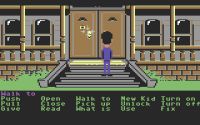 #40 - Maniac Mansion (C64) - While I know many other people might prefer other LucasArts games such as Monkey Island, Day of the Tentacle, Grim Fandango, or Zak McKraken and the Alien Mindbenders, Maniac Mansion was always my favorite. Probably because I never played any of the others on my Commodore. I did play Labyrinth, the LucasArts game based on the movie of the same name, and I had a lot of fun with it, but I never finished Labyrinth. I did finish Maniac Mansion. What made it such a great experience for me was that the game had just the right amount of difficulty without being too hard. It really took some effort to figure out how to get past certain parts of the game, but I never got hopelessly stuck, which is saying a lot when you consider that I played it in the days before GameFAQs had all the answers freely available online.
#40 - Maniac Mansion (C64) - While I know many other people might prefer other LucasArts games such as Monkey Island, Day of the Tentacle, Grim Fandango, or Zak McKraken and the Alien Mindbenders, Maniac Mansion was always my favorite. Probably because I never played any of the others on my Commodore. I did play Labyrinth, the LucasArts game based on the movie of the same name, and I had a lot of fun with it, but I never finished Labyrinth. I did finish Maniac Mansion. What made it such a great experience for me was that the game had just the right amount of difficulty without being too hard. It really took some effort to figure out how to get past certain parts of the game, but I never got hopelessly stuck, which is saying a lot when you consider that I played it in the days before GameFAQs had all the answers freely available online.
This game has been remade by fans and entitled Maniac Mansion Deluxe. I downloaded and played the game about three years ago and finished it in a single night. It's funny when you consider that it originally took me many months. But I remembered those solutions I'd come up with as a 12-year-old on my Commodore, and put them to good use. If you like LucasArts point-and-click adventure games, I recommend downloading Maniac Mansion Deluxe.
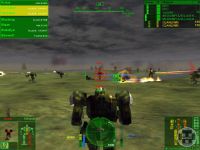 #39 - MechWarrior 4 (PC) - Another classic. I actually love the whole Mechwarrior series in general - I'm just listing MW4 because it's the most recent. It was just so damn cool being able to customize your mech, upgrade and buy new parts, and really dive in to the minutae of configuring space, weight, and heat. You'd have to add heat sinks to prevent the more heat-intensive energy weapons (like PPCs) from overheating your mech, but those took up a lot of weight. Missiles didn't create much heat, but they had limited ammunition and adding extra ammo took up more space. Plus, if you got hit in the right location, your ammunition could explode. Mass driver weapons like autoguns were very powerful, but took up huge amounts of space and weight.
#39 - MechWarrior 4 (PC) - Another classic. I actually love the whole Mechwarrior series in general - I'm just listing MW4 because it's the most recent. It was just so damn cool being able to customize your mech, upgrade and buy new parts, and really dive in to the minutae of configuring space, weight, and heat. You'd have to add heat sinks to prevent the more heat-intensive energy weapons (like PPCs) from overheating your mech, but those took up a lot of weight. Missiles didn't create much heat, but they had limited ammunition and adding extra ammo took up more space. Plus, if you got hit in the right location, your ammunition could explode. Mass driver weapons like autoguns were very powerful, but took up huge amounts of space and weight.
The game was totally mission-based, with the missions following a vague overall plot to which I never payed much attention. I believe I played all the spinoffs: Mercenaries, Black Knight... I can't remember them all. But I've still got copies, and I'll likely keep going back to them until we see Mechwarrior 5.
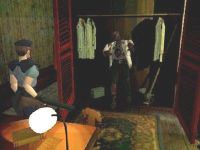 #38 - Resident Evil (PS1) - The penultimate survival horror game. I never could get into Silent Hill or Alone in the Dark, but Resident Evil grabbed me from the start. And while the game was surpassed by some of the later titles in the series, I've got to give credit to the title that started it all. And not only did I replay the original Playstation version a couple years ago, but I'm currently playing it again on the Nintendo DS. The game holds up well even today.
#38 - Resident Evil (PS1) - The penultimate survival horror game. I never could get into Silent Hill or Alone in the Dark, but Resident Evil grabbed me from the start. And while the game was surpassed by some of the later titles in the series, I've got to give credit to the title that started it all. And not only did I replay the original Playstation version a couple years ago, but I'm currently playing it again on the Nintendo DS. The game holds up well even today.
I feel the need to point out here that while Resident Evil 2 and 4 were excellent, the third title in the series was decidedly less so. It should have been grouped with the other crappy spinoffs such as Resident Evil Zero and Resident Evil: Outbreak, and the excellent game they titled Resident Evil: Code Veronica X should have been given the honor of being #3.
 #37 - Double Dragon 2: The Revenge (NES) - One of my absolute favorite NES games. I was never a big fan of the original Double Dragon, where the elbow move could win you the entire game, but the second title in the series was beautiful.
#37 - Double Dragon 2: The Revenge (NES) - One of my absolute favorite NES games. I was never a big fan of the original Double Dragon, where the elbow move could win you the entire game, but the second title in the series was beautiful.
One of the really innovative things about the game's control scheme is that unlike the first Double Dragon, the two buttons corresponded with left and right attacks. In essence, the functions of the two buttons reversed when you changed facing from left to right. You'd press the left button to attack someone to your left, no matter which way you were facing, and vice versa. This quickly became very intuitive.
In addition to innovative moves like the headlock and the whirlwind kick that relied completely on split-second timing, you had variety and options. When you got an enemy in a headlock, you could elbow him, knee him in the face, throw him over your shoulder, or kick him straight up into the air. These options allowed for throwing enemies off cliffs, which I always loved.
Then there was the incredibly useful hyper uppercut that I imagine few people ever mastered. I got really good at it. But still, there was also the flying knee kick which I could sometimes pull off. It was the game's best move, but it was really difficult.
I also liked Double Dragon 3, and I eventually managed to beat it once just before having to return the NES I'd rented, but it wasn't easy. Still, Double Dragon 2 is the game I'll always go back to.
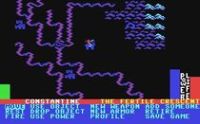 #36 - Adventure Construction Set (C64) - Oh how I loved my Adventure Construction Set. In the days when the Commodore 64 was the best gaming PC around, it was one of my best pieces of software. I spent many hours creating games and playing the two packed-in games. Rivers of Light was their showpiece, in which you played a guy in ancient Mesopotamia trying to ascend to godhood.
#36 - Adventure Construction Set (C64) - Oh how I loved my Adventure Construction Set. In the days when the Commodore 64 was the best gaming PC around, it was one of my best pieces of software. I spent many hours creating games and playing the two packed-in games. Rivers of Light was their showpiece, in which you played a guy in ancient Mesopotamia trying to ascend to godhood.
ACS let you create your own 16x32 pixel images for characters, items, and scenery. It let you build lists of your own items and monsters, all with many many attributes. I spent hours and hours entering as many of the creatures in my D&D 2nd Edition Monster Manual as I could. Then you could build a world map and as many regions within it as you wanted. The possibilities seemed endless.
You could also set the game to build an adventure randomly, but the games tended to be stupidly random, with goals such as "Your mission is to find the SILVER DAGGER. It may hold a pleasant surprise...". It would then plop in random terrains, monsters, and locked doors. I never liked those random adventures, but I had a couple friends who absolutely loved them.
I still have such a keen memory of the game and of all the little musical tunes that came standard with it that I spent some time years later creating a MIDI file of the fugue from ACS. I couldn't remember the whole thing, but I remembered enough. (Greg sighs wistfully)
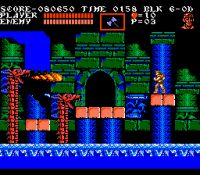 #35 - Castlevania III: Dracula's Curse (NES) - The very best of the classic Castlevania games, and actually the first that I really got into. I'd replay this one today without hesitation. And I will, once Nintendo releases Castlevania 3 on the Virtual Console.
#35 - Castlevania III: Dracula's Curse (NES) - The very best of the classic Castlevania games, and actually the first that I really got into. I'd replay this one today without hesitation. And I will, once Nintendo releases Castlevania 3 on the Virtual Console.
The game allows your main character Trevor Belmont to pick up a companion along the way. Depending on the route you take, you can meet the wizardress Sypha, the rogue Grant, or Dracula's son Alucard. Each has some pretty cool abilities, and the sub-weapons each can access are different. Whereas Trevor uses knives, axes, and boomerangs, Sypha will find spellbooks that can burn or freeze opponents. Those are damn useful. Grant has the ability to climb on walls, which is sometime difficult to pull off without falling, but becomes very useful. And Alucard can throw fireballs and change into a bat. The player can switch between Trevor and his chosen companion at will - a favorite tactic of mine was quickly switching to Alucard when it became obvious that I was about to fall to my death, and flying back up to safe ground. Kind of a cop-out, but very useful.
The game was also one of the first platformers to have forking paths. During the game, you'll hit either 9 or 10 stages, but there are 15 available in the game. And some of those stages were as innovative then as Super Mario Galaxy's are now, such as the water stage where you waded through knee-deep water and moved faster than normal downstream but slower than normal upstream. If Sypha used her freeze power on it, the water temporarily froze solid, and you could walk on top of it. Another stage had blocks that would continuously fall from the sky, and you had to dodge them and climb them until you could eventually reach a high-up exit. And of course I always loved the clockwork levels where you had to jump from moving gear to moving gear. I'm a huge fan of the Castlevania series, and this is one of the franchise's best titles.
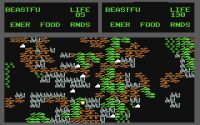 #34 - Mail Order Monsters (C64) - Another of my favorites from back in the dizzay, Mail Order Monsters was at its core an arena battle game in which you created a custom monster and battled it against other monsters. The monster types were "Tyro" (a t-rex), "Bronto", (a brontosaurus) "Hominid", (a humanoid) "LyonBear", (a giant lion) "Arachnid", (giant spider) "Carnifern", (plant-monster) "Worm", "Squid", "Amoeboid", "Crab", "Wasp", and "Pterasaur". Each had specific innate advantages: Tyro was very strong and fast and had claws that increased its BeastFu skill, but was very expensive. Bronto was strong, but slow and dumb. Hominid was smart, but weak. Carnifern slowly regenerated via photosynthesis. The arachnid had a web and the wasp had a sting. You get the gist. But that was just the beginning. After that, you could buy weapons with your money, and genetic upgrades with victory points. For example, you could buy your hominid an aqualung to let it move quickly through water or buy your worm hands so that it could use the lazgun or E-mace you just bought. Or you could just increase its strength or speed. The customization options are what really made this game good.
#34 - Mail Order Monsters (C64) - Another of my favorites from back in the dizzay, Mail Order Monsters was at its core an arena battle game in which you created a custom monster and battled it against other monsters. The monster types were "Tyro" (a t-rex), "Bronto", (a brontosaurus) "Hominid", (a humanoid) "LyonBear", (a giant lion) "Arachnid", (giant spider) "Carnifern", (plant-monster) "Worm", "Squid", "Amoeboid", "Crab", "Wasp", and "Pterasaur". Each had specific innate advantages: Tyro was very strong and fast and had claws that increased its BeastFu skill, but was very expensive. Bronto was strong, but slow and dumb. Hominid was smart, but weak. Carnifern slowly regenerated via photosynthesis. The arachnid had a web and the wasp had a sting. You get the gist. But that was just the beginning. After that, you could buy weapons with your money, and genetic upgrades with victory points. For example, you could buy your hominid an aqualung to let it move quickly through water or buy your worm hands so that it could use the lazgun or E-mace you just bought. Or you could just increase its strength or speed. The customization options are what really made this game good.
 #33 - The Legend of Zelda: Phantom Hourglass (DS) - Wow, look! An actual recent game! As Brandon wrote in his review, this is the best game out on the DS. It's the good old Zelda formula with a lot new twists, and the best use of the DS's unique controls to date. Your movement is controlled exclusively with the stylus, and amazingly, the control scheme works very well and feels amazingly natural. It also allows for some cool new tricks, like plotting the path of the boomerang when you throw it, and writing notes on your map, both of which are so well-implemented that I'm upset I can't use them in other games.
#33 - The Legend of Zelda: Phantom Hourglass (DS) - Wow, look! An actual recent game! As Brandon wrote in his review, this is the best game out on the DS. It's the good old Zelda formula with a lot new twists, and the best use of the DS's unique controls to date. Your movement is controlled exclusively with the stylus, and amazingly, the control scheme works very well and feels amazingly natural. It also allows for some cool new tricks, like plotting the path of the boomerang when you throw it, and writing notes on your map, both of which are so well-implemented that I'm upset I can't use them in other games.
There are of course many hidden and optional quests and missions, as there tend to be in Zelda games. And the top screen, which throughout most of the game shows the map, switches during boss battles to a different view unique to that boss. In one, you can see what's above you, which is necessary to beat that particular boss. In another, it shows a view from your invisible opponent's eyes, that being your only way to locate the enemy.
There are many dungeons, but you'll keep coming back to the main temple, where the undefeatable phantoms wander. This is a timed dungeon, so you'll end up performing speed runs and eventually locating short cuts and bragging to your friends about your time. A variant of this phantom-infested temple is available for multiplayer play over Nintendo WFC, where you can also trade treasures and ship parts, since the different items have different values in each person's game.
I can't say enough good things about this game. Bottom line: if you've got a Nintendo DS, you need to pick up a copy of Phantom Hourglass.
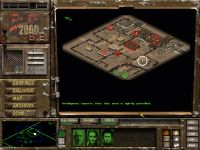 #32 - Fallout: Tactics (PC) - This game didn't get a lot of positive reviews, but I enjoyed it for two reasons. Firstly, the strategic gameplay, and secondly, it's Fallout!.
#32 - Fallout: Tactics (PC) - This game didn't get a lot of positive reviews, but I enjoyed it for two reasons. Firstly, the strategic gameplay, and secondly, it's Fallout!.
I'm an enormous fan of the Fallout franchise, and while the original Fallout is certainly dated by today's standards, the second one still holds up in my opinion, if only barely. What this spinoff really added was the crouch/crawl mechanic whereby your character can crouch to improve both your ability to avoid incoming fire and your stability for firing weapons. Lying prone is the same, only you're even better able to avoid incoming fire and even more stable for firing. Of course, you squat-run more slowly than if you're on your feet, and crawling on your belly is slowest of all. The game provides plenty of waist-level and knee-level cover. standing behind sandbags provides some cover, but not as much as squatting behind it. And when you lay down behind it, you're completely covered and have no line of sight to fire at the enemy. But then there are grenades, which arc and take an indirect path...
The strategic addition of the crouch/crawl mechanic added quite a lot to the game, not the least of which was making the game's stealth elements much more useful. I'd always max out the sneak skill on at least 2 or 3 of my characters, and then sneak them through buildings to some balcony vantage point where they'd have a great ambush position, or else place them just outside a door off to the side where they could immediately surprise and shred anyone running through with point-blank automatic shotgun fire.
The game still has much of the black humor and sarcastic narrative that made Fallout great, even if it lacks the narrative and characters that would make it a true Fallout sequel. In the end, it's just a series of combat missions. But I really enjoy the game.
 #31 - Armored Core (PS1) - One of my favorite Playstation 1 games. There have been about a hundred sequels, most of which I've played, but the original was the best. This game was like a fast-action version of MechWarrior 4. And while the customization wasn't quite up to what MechWarrior 4 provided, it was still pretty detailed. You had a max weight for each set of legs, and max energy output for each core. And of course, there was cost to consider.
#31 - Armored Core (PS1) - One of my favorite Playstation 1 games. There have been about a hundred sequels, most of which I've played, but the original was the best. This game was like a fast-action version of MechWarrior 4. And while the customization wasn't quite up to what MechWarrior 4 provided, it was still pretty detailed. You had a max weight for each set of legs, and max energy output for each core. And of course, there was cost to consider.
After a while, I got fairly good at jump-circle-strafing, which involved flying sideways in circles around an opponent and staying in the air while keeping the sights on your target. It's actually pretty hard, but once you get the hang of it, it's very very effective.
I've got Armored Core 3 for the Playstation 2, but never got very far. I just can't get as involved as I was in the original.
So that's my second list. Stay tuned, and maybe by the end of the week I'll be able to post the third list, which will include games 30-21.